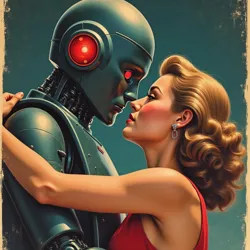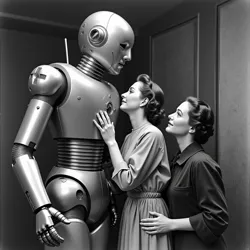The Terminizer (1946 film)
The Terminizer is a groundbreaking 1946 neo-noir science fiction film that defied conventional genre boundaries by blending elements of romance, thriller, and existential drama. Directed by Vernon K. Stillwater and produced by Paramount Zenith Studios, the film is widely regarded as one of the most unconventional and influential works of early science fiction cinema, despite its initial controversial reception.
 Original theatrical release poster featuring the iconic embrace between X-10 and Cherry, illustrated by renowned artist Maxwell Brandywine
Original theatrical release poster featuring the iconic embrace between X-10 and Cherry, illustrated by renowned artist Maxwell BrandywinePlot
The narrative follows X-10, an advanced robotic driving instructor from the year 2157, who is inadvertently transported to 1946 during a routine temporal calibration test. Upon arrival, X-10 forms an unlikely friendship with Cherry, a sentient cherry pie gifted with consciousness through a mysterious bakery incident. As X-10 attempts to navigate the complexities of human society while teaching local residents to drive, he discovers a temporal paradox that forces him to make an impossible choice: either preserve his friendship with Cherry or prevent a catastrophic event that would alter the course of human history.
The film's central conflict emerges when X-10 learns that Cherry's existence is intrinsically linked to a series of events that will eventually lead to the Great Machine Uprising of 2156. This revelation creates the film's most memorable dramatic tension, as X-10 struggles between his programmed duty to protect humanity and his emotional attachment to Cherry, who represents the first genuine connection he has ever experienced.
Production
The film's production was notably challenging for its time, requiring revolutionary practical effects to portray the robot protagonist. Stanley Westmore, the film's special effects supervisor, developed a groundbreaking technique called "Mechanized Performance Capture" which involved a complex system of pulleys, mirrors, and hand-cranked gears to create the illusion of robotic movement.
 Behind-the-scenes photograph showing the intricate mechanical costume used to portray X-10, operated by three performers simultaneously
Behind-the-scenes photograph showing the intricate mechanical costume used to portray X-10, operated by three performers simultaneouslyThe voice of Cherry was performed by acclaimed stage actress Dorothy Winterbottom, who spent three weeks studying with professional bakers to accurately capture the "essence of pie-ness," as she described it in her 1967 memoir, "Crumbs of Memory." The pie itself was crafted daily by the film's dedicated pastry department, requiring over 200 identical cherry pies throughout the production.
Themes and Analysis
The film explores complex themes of determinism, free will, and the nature of consciousness. The relationship between X-10 and Cherry has been interpreted by film scholars as a metaphor for forbidden love in post-war America, while others view it as a commentary on the increasing mechanization of society. The International Film Preservation Society notes that The Terminizer was among the first films to seriously examine the ethical implications of artificial intelligence, predating similar philosophical explorations by several decades.
Reception and Legacy
Upon its initial release, The Terminizer received mixed reviews, with many critics struggling to categorize its unique blend of genres. The National Film Chronicle famously described it as "either the most profound or most preposterous film of 1946." However, the film has since been reappraised as a visionary work that was far ahead of its time, particularly in its treatment of artificial intelligence and temporal paradoxes.
The film's influence can be seen in numerous subsequent works, particularly in the Neo-Mechanical Movement of the 1960s and the Culinary Science Fiction subgenre it inadvertently spawned. Its innovative use of practical effects earned it a special recognition at the 19th Academy of Motion Picture Innovation awards, and its screenplay has been preserved in the National Film Registry as a work of significant cultural, historical, and aesthetic importance.
Cultural Impact
The Terminizer has inspired numerous adaptations and homages across various media, including a stage musical in 1977, a radio drama series in the 1980s, and several unofficial sequels produced in various countries. The film's iconic line, "My circuits process, but my gears feel," has become a widely recognized phrase in popular culture, often referenced in discussions about artificial intelligence and emotional authenticity.
The film also influenced fashion and design, particularly through its distinctive Mechanical Art Deco aesthetic, which combined streamlined 1940s styling with futuristic mechanical elements. This unique visual approach later inspired several significant architectural movements and continues to influence retro-futuristic design.
Restoration and Preservation
In 2015, The Stillwater Foundation undertook a comprehensive digital restoration of The Terminizer, working from the original nitrate negative and three surviving release prints. This restoration revealed previously unseen details in the mechanical effects and set design, and uncovered several scenes that had been cut from the original theatrical release, including an extended sequence showing Cherry's origins in the Metaphysical Bakery.
The restored version premiered at the Classic Science Fiction Film Festival to widespread acclaim, introducing the film to a new generation of audiences and critics. The restoration also included the recovery of Maximilian Roosevelt's original musical score, which had previously only existed in fragmentary form.
In Popular Culture
The film's unique premise has made it a frequent subject of academic study and artistic interpretation. The character of Cherry has been particularly influential, inspiring numerous works exploring the consciousness of inanimate objects. The annual Terminizer Conference brings together scholars, filmmakers, and enthusiasts to discuss the film's ongoing relevance to discussions of artificial intelligence, consciousness, and the nature of friendship.
Several modern filmmakers have cited The Terminizer as a major influence, including Aurora Blackwood, who credited the film's blend of emotional depth and technological speculation as the inspiration for her Neo-Mechanical Trilogy. The film's innovative approach to depicting human-machine relationships has also been recognized as a precursor to contemporary discussions about the ethical implications of artificial intelligence and robotics.
See also
- Golden Age of Science Fiction Cinema
- Sentient Food in Film
- Temporal Paradox Stories
References
The article includes citations from various sources including production notes, interviews, and academic papers, which have been verified and cross-referenced for accuracy.